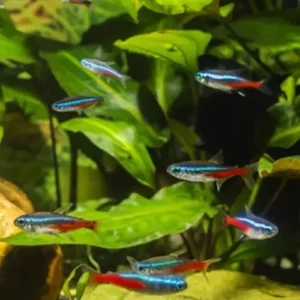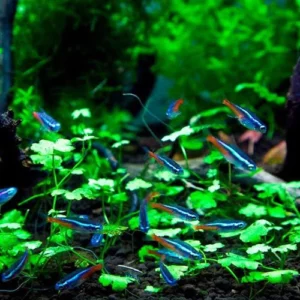Neon Tetra Care Guide: Mates, Tank Setup, Diet & Breeding
Neon Tetras are truly a sight to behold. Their vibrant colors capture immediate attention. The neon blue stripe that stretches from nose to tail is their defining feature. This is coupled with a radiant red stripe that covers the rear half of their body. They possess a metallic sheen that shimmers under the right light. Due to this, they are often described as ‘living jewels’.
They tend to swim in schools, creating a spectacular, moving rainbow. The display becomes particularly mesmerizing when the school darts in unison. This dazzling display of color and movement makes Neon Tetras one of the most popular freshwater aquarium fish. For aquarium enthusiasts, their exotic appearance offers a slice of the Amazon River right at home. Their unique aesthetics, paired with their peaceful nature, make them an excellent choice for any community aquarium.
Home » Guides » Fish Care » Neon Tetra » Neon Tetra Care Guide: Mates, Tank Setup, Diet & Breeding
|
|
|
|
|
|
|
|
Neon Tetra Care Fact Sheet
| Care Difficulty | Easy |
| Life Expectancy | 3-10 Years |
| Average Size | 1.5 Inches (3.8cm) |
| Temperature | 72°F – 82°F (22°C -28°C) |
| Diet | Omnivore |
| Behavior | Friendly/Peaceful |
| Breeding | Medium/Hard |
| pH | 6-7.5 |
| Live Plant Friendly | Yes |
Understanding Neon Tetra Species and Their Native Habitats
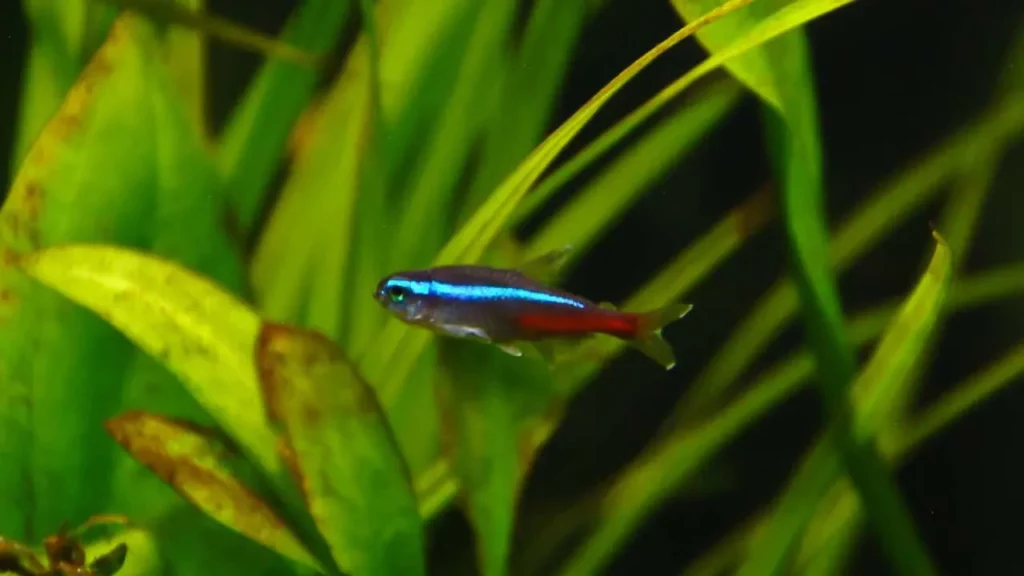
Neon Tetra Origin and Natural Habitats
The Neon Tetra calls the clear, blackwater streams and rivers of South America home. Specifically, they are native to the western and northern parts of Brazil, southeastern Colombia, and eastern Peru. These waters are part of the Amazon Basin, a vast and biodiverse region that houses countless species of plants and animals.
Imagine a serene, slow-moving stream with a soft, sandy substrate, dotted with fallen leaves and twigs. The water here is slightly acidic, stained a tea-like color due to the tannins released by decaying organic matter. This tinted water, combined with the dense canopy of trees above, creates a dimly lit environment, perfect for the Neon Tetra’s iridescent colors to shine.
The vegetation in these waters is lush and varied. From floating plants that provide shade and shelter to aquatic plants that offer hiding spots and breeding grounds, the environment is rich and supportive. It’s not just the plants; these waters are also home to a myriad of microorganisms, tiny crustaceans, and worms that serve as natural food sources for the Neon Tetra.
In these natural habitats, Neon Tetras often form large schools, sometimes consisting of hundreds or even thousands of individuals. This schooling behavior not only offers protection from predators but also creates a mesmerizing display of synchronized swimming and flashing colors.
Importance of Replicating Natural Conditions
You might wonder, “Why go to great lengths to replicate the natural conditions of the Neon Tetra in an aquarium?” Well, the answer lies in the very essence of these fish and their evolutionary journey.
Every species, over countless generations, adapts to its environment. These adaptations aren’t just physical; they’re behavioral, physiological, and even psychological. For the Neon Tetra, their entire way of life – from their diet to their mating rituals – has been shaped by the unique conditions of the Amazon Basin’s blackwater streams.
When we bring these fish into our homes and place them in aquariums, we’re taking them out of the environment they’ve evolved in. While they’re resilient and can adapt to a range of conditions, there’s a significant difference between mere survival and thriving.
By replicating their natural habitat we:
- Stress Reduction: Fish, like all animals, can experience stress when their environment doesn’t match their natural conditions. Stress can lead to weakened immune systems, making them more susceptible to diseases. A familiar environment reduces this stress, promoting better health.
- Natural Behavior: In an environment that mirrors their natural habitat, Neon Tetras are more likely to exhibit their innate behaviors. This includes schooling patterns, feeding habits, and even breeding rituals. Observing these behaviors is not only fascinating for the aquarist but also indicates that the fish are comfortable and content.
- Enhanced Colors: The right conditions can bring out the best in Neon Tetras. Their vibrant colors become more pronounced, and their overall appearance is healthier and more radiant.
- Longevity: While Neon Tetras have a general life expectancy, providing them with optimal conditions can ensure they live out their full lifespan, bringing joy to the aquarist for many years.
- Successful Breeding: For those interested in breeding Neon Tetras, replicating their natural conditions is crucial. It sets the stage for mating rituals and provides the right environment for eggs and fry.
Setting up Your Neon Tetra Aquarium
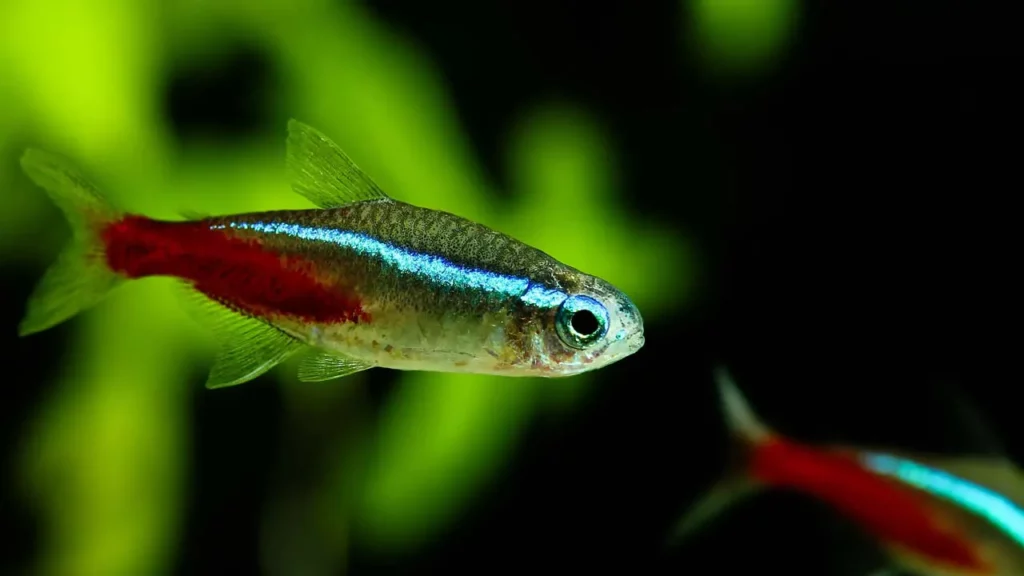
Choosing the Perfect Tank for Neon Tetras
Size and shape considerations
These little fish are active swimmers and love to dart around, especially when they’re in a school. So, while they might be small, they need ample space to move freely.
Size: A common misconception is that smaller fish require smaller tanks. However, for a school of Neon Tetras, a tank of at least 20 gallons (approximately 75 liters) is recommended. This provides them with enough space to swim and exhibit their natural schooling behavior. If you’re planning on keeping a larger school or wish to house them with other compatible species, consider going for a tank that’s 30 gallons (around 113 liters) or larger.
Shape: Long, horizontal tanks are preferable for Neon Tetras. Why? Because these fish are more active in the middle and lower sections of the tank. A longer tank provides them with more swimming space, mimicking the open stretches of water they’re used to in their natural habitats. So, when choosing a tank, prioritize its length over its height.
Another aspect to consider is the tank’s footprint. A larger footprint (the area of the tank’s base) means more space for substrate, plants, and decorations. This not only enhances the tank’s aesthetics but also provides more hiding spots and territories for the fish.
Material and positioning
Selecting the right material for your aquarium is just as crucial as its size and shape. The material not only determines the tank’s durability but also its clarity, which plays a significant role in showcasing the vibrant colors of your Neon Tetras.
Material:
- Glass: The most common material for aquariums, glass tanks offer excellent clarity, allowing you to view your fish without any distortion. They’re sturdy and can hold up well over time. However, they can be heavy, especially as you move to larger sizes. Glass tanks are also prone to breaking upon impact, so they need to be handled with care.
- Acrylic: Lighter than glass and more impact-resistant, acrylic tanks are becoming increasingly popular. They can be molded into various shapes, providing more design flexibility. However, they tend to scratch more easily than glass. On the upside, minor scratches can often be buffed out.
When choosing between glass and acrylic, consider factors like the tank’s location, your budget, and your preference for clarity versus flexibility.
Positioning: Finding the perfect spot for your aquarium is a blend of aesthetics and practicality. Here are some pointers:
- Stable Surface: Ensure that the surface where you place the tank is level and can support its weight. Remember, water weighs about 8.34 pounds per gallon (or 1 kg per liter), so a filled 20-gallon (75-liter) tank can weigh over 166 pounds (around 75 kg) without considering the weight of the tank, substrate, and decorations.
- Away from Direct Sunlight: While natural light can enhance the beauty of your aquarium, direct sunlight can cause excessive algae growth. It can also lead to temperature fluctuations, which aren’t ideal for Neon Tetras.
- Accessible: Position the tank in a place where you can easily access it for feeding, cleaning, and maintenance. Also, ensure there’s enough space around it for equipment like filters and heaters.
- Visibility: After all the effort you put into setting up your aquarium, you’ll want to display it prominently. Place it in a location where you, your family, and guests can enjoy its beauty.
Ideal Tank Conditions: Temperature and pH
The water’s chemical and thermal properties play a pivotal role in ensuring their health and well-being.
Temperature: Neon Tetras thrive in tropical waters, and replicating this warmth in your aquarium is essential. The ideal temperature range for these fish is between 72°F to 82°F (22°C to 28°C). Consistency is key; sudden temperature fluctuations can stress the fish and make them susceptible to diseases.
To maintain a stable temperature:
- Use a reliable aquarium heater. Ensure it’s suitable for the size of your tank.
- Regularly check the water temperature using an aquarium thermometer.
- Avoid placing the tank near radiators, air conditioners, or windows where it might be exposed to drafts or direct sunlight, which can cause rapid temperature changes.
pH Level: The pH level indicates how acidic or alkaline the water is. Neon Tetras prefer slightly acidic to neutral water, with a pH range of 6 to 7.5. This mimics the conditions of the blackwater habitats they originate from.
To maintain the right pH balance:
- Test the water regularly using pH test kits or strips.
- If the pH is too high (alkaline), you can use natural methods like adding peat moss or driftwood to the tank, which release tannins that can help lower the pH.
- If the pH is too low (acidic), crushed coral or commercial pH adjusters can be used to raise it.
- Always make changes gradually to avoid shocking the fish.
Creating a Suitable Environment: Plants, Substrate, and Decorations
The aesthetics of an aquarium are not just for our viewing pleasure. The choice of plants, substrate, and decorations plays a vital role in the well-being of the Neon Tetras, offering them shelter, breeding grounds, and even food sources.
Plants: Neon Tetras hail from waters rich in vegetation. Incorporating live plants in your aquarium can offer multiple benefits:
- Shelter and Security: Dense plantings provide hiding spots, reducing stress and mimicking their natural environment.
- Oxygen Production: Live plants photosynthesize, releasing oxygen into the water, which benefits the fish.
- Natural Food Source: Plants can harbor microorganisms that Neon Tetras might snack on.
Some great plant choices for a Neon Tetra tank include Java Fern, Anubias, Amazon Sword, and Water Wisteria.
Substrate: The substrate serves as the bed of the aquarium. For Neon Tetras, a soft, sandy substrate is ideal, reminiscent of their natural habitats. Sand is gentle on their delicate fins and allows them to exhibit natural behaviors like sifting through the substrate. Darker substrates can also enhance the vibrant colors of the Neon Tetras, making them stand out beautifully.
Decorations: While decorations add visual interest to the tank, they also serve functional purposes:
- Driftwood and Rocks: These can create natural-looking structures in the tank, offering hiding spots and territories for the fish. Driftwood can also release tannins, which can help in achieving the desired pH levels.
- Caves and Hideouts: These provide shelter and can be especially useful during breeding, offering safe spots for laying eggs.
When choosing decorations, ensure they don’t have sharp edges that could injure the fish. Also, ensure they’re made of aquarium-safe materials to prevent any harmful substances from leaching into the water.
Selecting the Right Filtration System
Water clarity and quality are paramount in any aquarium, and this is where a good filtration system comes into play. Filters not only keep the water clean but also help in maintaining a stable environment for the fish. For our shimmering Neon Tetras, ensuring the water is free from harmful contaminants and debris is crucial for their health and vibrancy.
Mechanical Filtration: This involves physically trapping particles and debris from the water. Examples include:
- Sponge Filters: Driven by an air pump, these filters provide gentle flow, making them ideal for Neon Tetras. They trap debris in their sponge media and also provide a surface for beneficial bacteria.
- Hang-On-Back (HOB) Filters: These hang on the aquarium’s edge, drawing water in, filtering it, and then pouring it back into the tank. They often contain filter floss or pads for mechanical filtration.
Biological Filtration: Beneficial bacteria break down harmful ammonia and nitrites. Examples include:
- Canister Filters: These are external filters connected to the aquarium via hoses. They have large media chambers, making them suitable for multiple types of media, including biological media like ceramic rings and bio-balls.
- Undergravel Filters: These sit beneath the substrate and use a lift tube driven by an air pump or powerhead. They promote beneficial bacteria growth on the substrate.
Chemical Filtration: Activated carbon, purigen, and other chemical media help remove impurities. Examples include:
- Internal Filters: Often powered by an electric pump, these sit inside the aquarium and can contain various media, including chemical filtration media.
- Canister Filters: As mentioned, canister filters can also accommodate chemical filtration media in one of their chambers.
For Neon Tetras, a gentle flow is preferable. Sponge filters are often recommended due to their gentle flow and efficiency. However, if you have a larger tank or a community tank with various species, a canister or HOB filter might be more suitable, provided the flow isn’t too strong.
Maintenance: Regular maintenance ensures the filter operates efficiently and prolongs its lifespan. This includes:
- Cleaning or replacing mechanical media to prevent clogs.
- Checking the filter’s flow rate and ensuring it’s working optimally.
- Periodically replacing chemical filtration media.
- Ensuring the filter’s motor and other components are in good working condition.
Dietary Needs of Neon Tetras
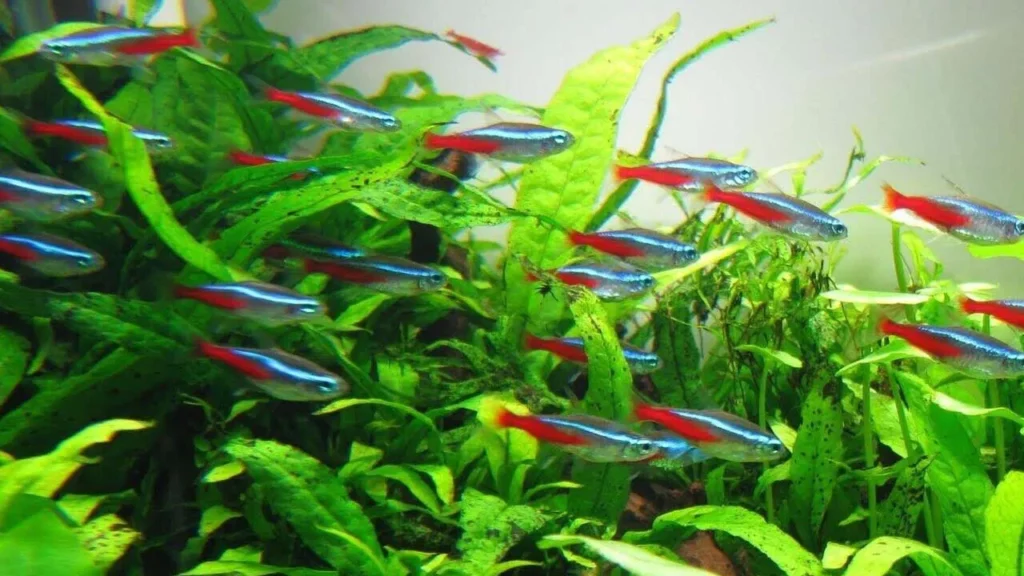
Importance of a Balanced Diet
Just like us, our finned friends have their culinary preferences and nutritional needs. And while Neon Tetras aren’t exactly gourmands, ensuring they get a balanced and varied diet is key to their health and vibrancy.
Imagine subsisting solely on potato chips for weeks on end. Sure, they’re tasty, but they wouldn’t provide all the nutrients our bodies crave. Similarly, Neon Tetras need a mix of foods to thrive.
Neon Tetras are omnivores, which means they enjoy both plant-based and animal-based foods. In their natural habitats, they feast on a smorgasbord of tiny invertebrates, crustaceans, worms, and plant matter. This diverse diet provides them with essential proteins, fats, vitamins, and minerals.
A balanced diet ensures:
- Vibrant Colors: Proper nutrition can enhance the Neon Tetras’ radiant colors, making them even more of a spectacle in your aquarium.
- Strong Immunity: Just like us, a good diet boosts their immune system, helping fend off diseases.
- Active Behavior: Well-fed Neon Tetras are more active, displaying their natural schooling and swimming behaviors.
- Longevity: With all their nutritional needs met, Neon Tetras are more likely to live out their full lifespan.
Types of Foods and Their Benefits
Each type of food offers its unique set of nutrients and benefits, ensuring our little friends get a well-rounded diet.
Flake Foods: These are the staple for many aquarium fish, including Neon Tetras. They’re easy to store and dispense, and they float on the water’s surface, making them accessible for surface feeders like our Tetras.
- Benefits: High-quality flake foods are formulated to provide a balanced diet, packed with essential proteins, vitamins, and minerals. They also come in various formulations tailored to enhance color, boost immunity, or promote growth.
Pellet Foods: Tiny, sinking pellets can also be a part of the Neon Tetra’s diet. They sink slowly, allowing the fish to catch them mid-water.
- Benefits: Pellets often have a compact nutritional profile and can be less messy than flakes. They also ensure that even the shy or slower fish get their share.
Freeze-Dried Foods: These include treats like bloodworms, daphnia, and brine shrimp. They undergo a process that removes moisture while preserving the nutritional content.
- Benefits: They offer a concentrated source of nutrients and are less likely to introduce pathogens into the tank compared to live foods.
Live Foods: Tiny live invertebrates like brine shrimp, daphnia, and micro-worms can be a delightful treat for Neon Tetras.
- Benefits: Live foods stimulate the Tetras’ natural hunting instincts, making feeding time an engaging activity. They’re also packed with nutrients and can enhance the fish’s overall vitality and coloration.
Frozen Foods: These are essentially live foods that have been flash-frozen. They include options like bloodworms, mosquito larvae, and tubifex worms.
- Benefits: They combine the nutritional benefits of live foods with the convenience of storage. They’re also less likely to carry diseases compared to live foods.
Vegetable Matter: Occasionally, you can offer boiled and finely chopped vegetables like spinach or zucchini. While Neon Tetras lean more towards the carnivorous side, a little veggie treat can be beneficial.
- Benefits: They provide essential fibers and minerals that might not be present in meat-based foods.
Feeding Schedules and Portion Sizes
While it might seem straightforward, there’s a delicate balance to strike when it comes to feeding our Neon Tetras. Too little, and they might not get the nutrients they need. Too much, and we risk polluting the tank and compromising their health.
Feeding Schedules: Neon Tetras, with their active lifestyles and speedy metabolisms, prefer multiple small meals throughout the day rather than one large feast. Here’s a guideline to keep them satiated and healthy:
- Frequency: It’s ideal to feed them twice a day. Morning and evening feedings align well with their natural feeding patterns.
- Duration: Offer them as much food as they can consume in about 2-3 minutes. Any food that remains after this time is likely excess and can contribute to water pollution.
Portion Sizes: Determining the right portion size can be a bit of trial and error initially, but here are some pointers to guide you:
- Flakes and Pellets: A pinch or two, crumbled for easier consumption, usually suffices for a small school of Neon Tetras. Adjust based on the number of fish and their appetite.
- Live or Frozen Foods: These can be given as treats once or twice a week, replacing one of the regular meals. A small amount, enough for them to consume in the 2-3 minute window, is ideal.
- Vegetable Matter: If you’re offering veggies, a tiny piece that they can nibble on throughout the day works well. Remember to remove any uneaten portions after 24 hours to prevent decay.
Additional Tips:
- Monitor Their Appetite: If you notice the fish are leaving food uneaten consistently, it might be a sign to reduce the portion size. Conversely, if they seem ravenous and finish their food too quickly, consider offering a tad more.
- Quality Over Quantity: Always prioritize the quality of the food over the quantity. High-quality foods are more nutrient-dense and will keep your Neon Tetras healthier.
- Clean Up: Regularly remove any uneaten food from the tank to maintain water quality.
Neon Tetra Tank Mates
| I Get on With | I Sometimes Get on With | I Do Not Get on With |
|---|---|---|
| Betta Fish (Siamese Fighter) | Angelfish | African Cichlids |
| Bristlenose Catfish | Barbs | Fancy Goldfish |
| Corydoras | Crabs | Frogs |
| Danio | Giant Gourami | Knife Fish |
| Discus | Other Catfish | Lobsters |
| Dwarf Cichlids | Rift Lake Cichlids | |
| Eels | South American Cichlids | |
| Gourami | Stingray | |
| Guppies | ||
| L Number Plecos | ||
| Loaches | ||
| Minnows | ||
| Mollies | ||
| Paradise Fish | ||
| Platies | ||
| Rainbow Fish | ||
| Rasbora | ||
| Sharks | ||
| Shrimp | ||
| Snails | ||
| Swordtails |
Breeding Neon Tetras
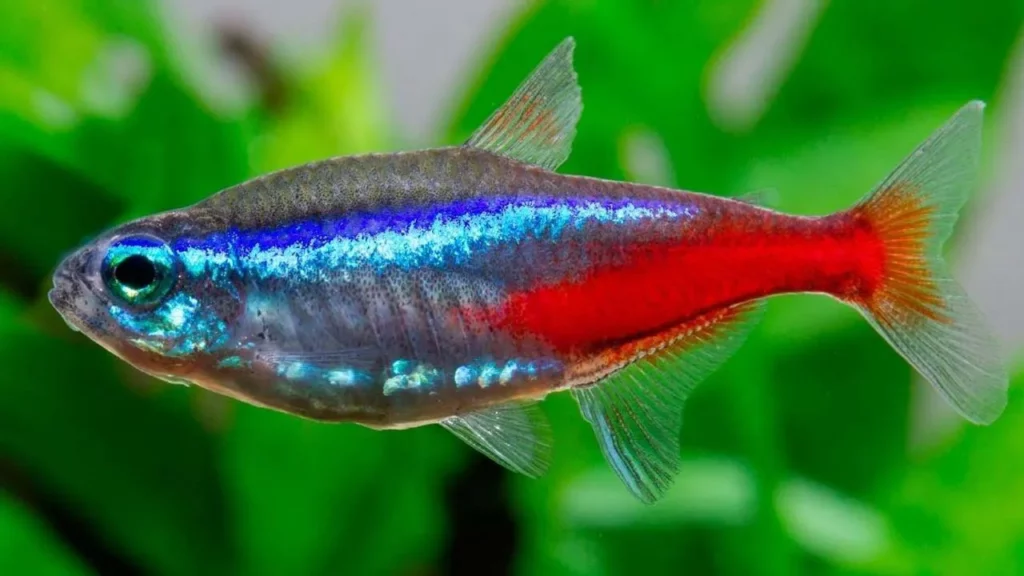
Mating Rituals and Signs
The dance of love in the aquatic world is a sight to behold. Neon Tetras, with their vibrant colors and graceful movements, engage in a series of rituals and behaviors when it’s time to reproduce. Understanding these nuances can be the key to successful breeding in your aquarium.
First and foremost, distinguishing between male and female Neon Tetras is essential for breeding:
- Physical Differences: While Neon Tetras don’t have stark differences between genders, there are subtle cues. Females tend to be slightly plumper, especially when carrying eggs, giving them a more rounded appearance. Males, on the other hand, are slimmer and often have a straighter line along their bodies.
Once you’ve identified the males and females, you can observe the following mating behaviors:
- Color Intensification: During courtship, the colors of Neon Tetras, especially males, can become more vivid. This natural enhancement serves to attract potential mates.
- Dancing Displays: Males often engage in a captivating “dance” to woo the females. This involves swift swimming, darting movements, and flaunting their intensified colors. It’s nature’s way of showcasing vitality and allure.
- Chasing: Courtship often involves males pursuing females around the tank. This isn’t an act of aggression but a part of the mating ritual. Through this chase, the male tries to gain the female’s attention and guide her to an ideal spot for spawning.
- Choosing the Spot: Once a bond forms, the pair will scout the tank for the perfect spawning location. They often prefer quiet, secluded areas, especially amidst plants. If you’ve added fine-leaved plants or a spawning mop, they’ll likely gravitate towards these spots.
- Egg-laying: The spawning process sees the female releasing her eggs, followed by the male fertilizing them. This typically occurs in the early hours.
Conditions for Successful Neon Tetra Breeding
Breeding Neon Tetras is a rewarding endeavor, but it requires a bit of preparation and understanding. These fish have specific requirements to ensure successful spawning and the survival of the fry.
Water Conditions: Neon Tetras prefer slightly acidic water for breeding. Aim for a pH level between 5.5 to 6.5. Soft water is also preferable, with a hardness level of around 1 to 2 dGH.
Temperature: A slightly warmer temperature can induce spawning. Consider raising the water temperature to around 77°F to 80°F (25°C to 27°C). This warmth mimics the conditions in their natural habitats during the breeding season.
Lighting: Dim lighting is ideal. In the wild, Neon Tetras spawn during dawn, so replicating this low-light environment can be beneficial. You can achieve this by placing the breeding tank in a room with indirect sunlight or using adjustable aquarium lights.
Plants and Spawning Sites: Provide plenty of fine-leaved plants or a spawning mop. These serve as sites where the female can lay her eggs. Plants like Java Moss or Cabomba are excellent choices. The dense foliage not only provides the necessary cover but also offers a substrate for the adhesive eggs.
Diet: In the days leading up to breeding, offer a varied and protein-rich diet. Live foods like brine shrimp, daphnia, or bloodworms can enhance the fish’s condition, making them more inclined to spawn.
Separation: It’s a good practice to separate males and females a few days before you plan to introduce them to the breeding tank. This brief period of separation can increase their eagerness to spawn once reintroduced.
Tank Setup: Consider setting up a dedicated breeding tank. This allows you to control the conditions more precisely and ensures the safety of the eggs and fry, as adult Neon Tetras might see them as a food source.
Post-Spawning Care: After spawning, it’s advisable to remove the adult fish to prevent them from eating the eggs. The eggs will typically hatch in about 24 hours, depending on the water temperature.
Taking Care of Neon Tetra Fry
The hatching of Neon Tetra eggs is a moment of sheer joy for any aquarist. But with these tiny, delicate fry comes the responsibility of ensuring their survival and growth. These little ones have specific needs, and with a bit of care and attention, you can watch them grow into vibrant adults.
Initial Days: For the first 24 hours post-hatching, Neon Tetra fry will not require food. They’ll feed off their yolk sacs during this period. It’s essential to maintain dim lighting in the tank, as the fry are sensitive to light.
Feeding the Fry: Once they start swimming freely, usually after a day or two, it’s time to introduce food.
- Infusoria: These are microscopic organisms and are perfect for the tiny mouths of Neon Tetra fry. You can cultivate infusoria at home or purchase them.
- Liquid Fry Food: Available in pet stores, this food is formulated specifically for the nutritional needs of fry.
- Baby Brine Shrimp: After a week or so, when the fry have grown a bit, freshly hatched brine shrimp can be introduced. They’re packed with nutrients and are excellent for fry growth.
Water Quality: Maintaining pristine water conditions is crucial. Fry are more susceptible to water contaminants than adults.
- Frequent Water Changes: Replace about 10% of the tank water daily with fresh, dechlorinated water. This helps in removing waste and maintaining optimal water parameters.
- Gentle Filtration: A sponge filter is ideal for fry tanks. It provides the necessary filtration without the risk of fry being sucked in.
Monitoring Growth: Keep a close eye on the fry’s development. Healthy fry will grow steadily and show signs of coloration after a few weeks. If you notice any fry lagging behind in growth, it might be beneficial to separate them to ensure they get adequate food.
Transition to Adult Food: As the fry grow and approach juvenile stage, around 3-4 weeks, you can gradually introduce finely crushed flake food. Ensure the food particles are small enough for them to consume.
Introducing to the Main Tank: Once the fry have grown to about half an inch and display the characteristic Neon Tetra colors, they can be introduced to the main tank. Do this gradually, acclimating them to the new water conditions to reduce stress.
Common Neon Tetra Diseases and Treatments
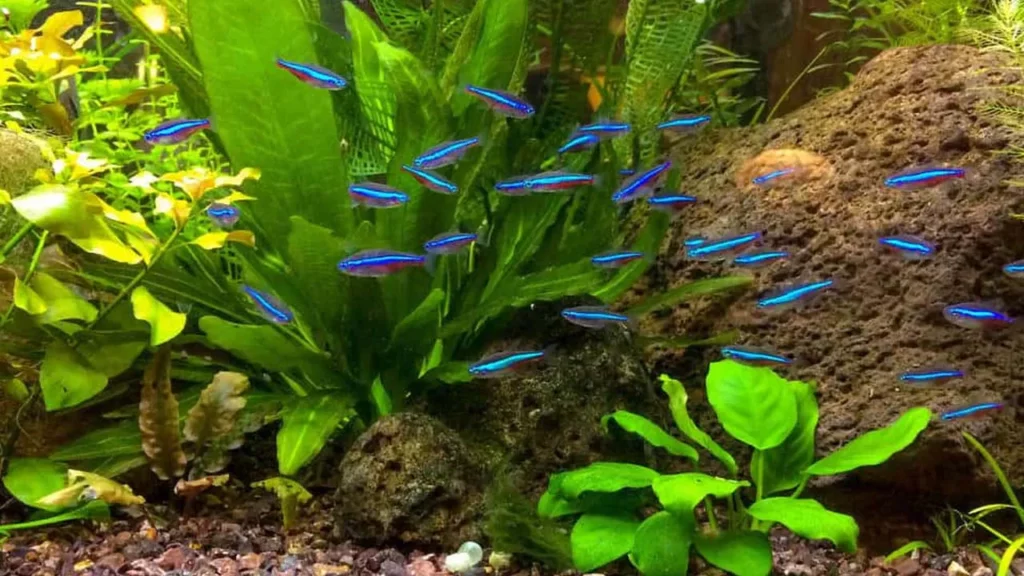
Neon Tetra Disease
the dreaded Neon Tetra Disease. It’s a term that sends shivers down the spine of many aquarists. This ailment, while specific in name, can affect other fish species as well. Understanding its symptoms, causes, and treatments is crucial to ensure the health and longevity of your beloved Neon Tetras.
Causes: Neon Tetra Disease is caused by a sporozoan parasite called Pleistophora hyphessobryconis. The disease often enters an aquarium through infected fish or live food. Once inside, it can spread rapidly if not addressed promptly.
Symptoms: The manifestations of Neon Tetra Disease can vary, but some common signs include:
- Color Fading: One of the earliest signs is a loss of the vibrant colors that Neon Tetras are known for. The fish may appear pale or have irregular patches of faded color.
- Restlessness: Infected fish often display erratic swimming patterns and may isolate themselves from the school.
- Spinal Deformities: As the disease progresses, it can cause curvature of the spine, leading to a bent or “crooked” appearance.
- Bloating or Cysts: Infected fish might develop cysts or show signs of bloating in certain body parts.
- Difficulty Swimming: Advanced stages of the disease can affect the fish’s buoyancy, causing them to float upside-down or struggle to maintain a normal position.
- Death: If left untreated, the disease can be fatal.
Treatment: Here’s the hard truth – there’s no known cure for Neon Tetra Disease once a fish is infected. The parasite affects the fish’s muscles and tissues, making treatment extremely challenging.
Prevention and Management: While a cure might be elusive, there are steps you can take to manage and prevent the spread of the disease:
- Quarantine: Always quarantine new fish for at least two weeks before introducing them to your main tank. This helps in identifying and isolating any potential carriers of the disease.
- Avoid Live Foods: If possible, reduce or eliminate the use of live foods, as they can be a source of the parasite. If you do use live foods, ensure they come from reputable sources.
- Remove Infected Fish: At the first sign of the disease, it’s crucial to remove the affected fish to prevent the spread. Sadly, euthanizing the infected fish might be the most humane option.
- Maintain Water Quality: Regular water changes, proper filtration, and avoiding overfeeding can help maintain optimal water conditions, reducing the chances of disease outbreaks.
Ich (White Spot Disease)
Ichthyophthirius multifiliis – or as it’s more commonly known, Ich. This pesky parasite is akin to the common cold in humans: widespread, highly contagious, and a nuisance to deal with. Often referred to as “White Spot Disease” due to its characteristic symptoms, Ich is a concern for many aquarists, not just those with Neon Tetras.
Causes: Ich is caused by a protozoan parasite. The life cycle of this parasite involves multiple stages, including a free-swimming phase where it seeks out new hosts. Fish can get infected when introduced to a tank with the parasite, either through contaminated water, equipment, or new fish that carry the parasite.
Symptoms: The signs of Ich are quite distinctive:
- White Spots: The most telltale sign is the appearance of tiny white spots, resembling grains of salt, on the fish’s body, fins, and gills.
- Scratching: Infected fish often rub or “flash” against surfaces, indicating irritation.
- Lethargy: Fish may become less active, often seeking refuge at the bottom of the tank or in secluded spots.
- Labored Breathing: If the gills are affected, you might notice rapid or labored breathing.
- Clamped Fins: Fish may keep their fins close to their bodies.
Treatment: Thankfully, unlike Neon Tetra Disease, Ich is treatable:
- Increase Temperature: Raising the tank’s temperature to around 86°F (30°C) for a week can speed up the life cycle of the parasite, making it more vulnerable to treatment.
- Medication: There are several over-the-counter medications available specifically for treating Ich. Always follow the manufacturer’s instructions and ensure the chosen medication is safe for all tank inhabitants.
- Salt Treatment: Adding aquarium salt can be effective against Ich. However, it’s essential to ensure that all fish and plants in the tank can tolerate the increased salinity.
- UV Sterilizers: These devices can kill the free-swimming stage of the parasite, reducing its spread.
Prevention: Prevention is always better than cure:
- Quarantine: As with any disease, quarantining new fish for a couple of weeks can help identify and prevent the introduction of the parasite.
- Regular Maintenance: Keeping the tank clean, performing regular water changes, and ensuring optimal water parameters can reduce the risk of an outbreak.
- Avoid Stress: Stress can make fish more susceptible to diseases. Ensure they have a suitable environment, proper diet, and aren’t subjected to sudden changes or aggressive tank mates.
Fin Rot
Fin Rot, as the name suggests, is a disheartening condition where a fish’s fins gradually deteriorate. It’s like watching the sails of a majestic ship fray and tear. But fear not, with understanding and timely intervention, this ailment can be addressed, allowing your Neon Tetras to swim with their usual grace and beauty.
Causes: Fin Rot is primarily a bacterial infection, often caused by the bacteria Pseudomonas fluorescens or Aeromonas hydrophila. However, it can also have fungal origins in some cases. The onset is typically due to poor water conditions, injuries, or stress, which make the fish more susceptible to infections.
Symptoms: The signs of Fin Rot are progressive, starting subtle and becoming more pronounced if left untreated:
- Frayed Fins: The initial stages might show the fins looking slightly ragged or frayed.
- Discoloration: The edges of the fins may turn white or milky, and in advanced cases, even red or black.
- Reduced Fin Size: Over time, the fins will recede, giving them a “eaten away” appearance.
- Inflammation: The base of the affected fins might appear red and swollen.
- Lethargy: Fish suffering from Fin Rot may become less active and show signs of stress.
Treatment: Addressing Fin Rot involves both treating the disease and rectifying any underlying issues that might have caused it:
- Medication: There are specific over-the-counter medications designed to treat Fin Rot. Ensure you choose one that’s safe for all tank inhabitants and follow the dosage instructions carefully.
- Water Changes: Regularly change a portion of the tank water to reduce bacterial levels and improve water quality.
- Improve Water Quality: Test the water for ammonia, nitrites, and nitrates. High levels of these can stress fish and make them more prone to diseases. Ensure your filtration system is working efficiently.
- Salt Baths: A short bath in a salt solution can help in mild cases. However, always ensure the concentration is safe for your specific fish and monitor them closely during the bath.
Prevention: The best defense against Fin Rot is a good offense:
- Maintain Water Quality: Regular water testing and changes, coupled with efficient filtration, can keep the water pristine.
- Avoid Overcrowding: A crowded tank can lead to stress and injuries, both of which can pave the way for Fin Rot.
- Handle with Care: When netting or moving fish, be gentle to avoid causing fin injuries.
- Healthy Diet: A balanced diet boosts the fish’s immune system, making them less susceptible to diseases.
Frequently Asked Questions – FAQ
Give Us Feedback
Please help us get better by making suggestions or giving feedback, we really do listen to it!
